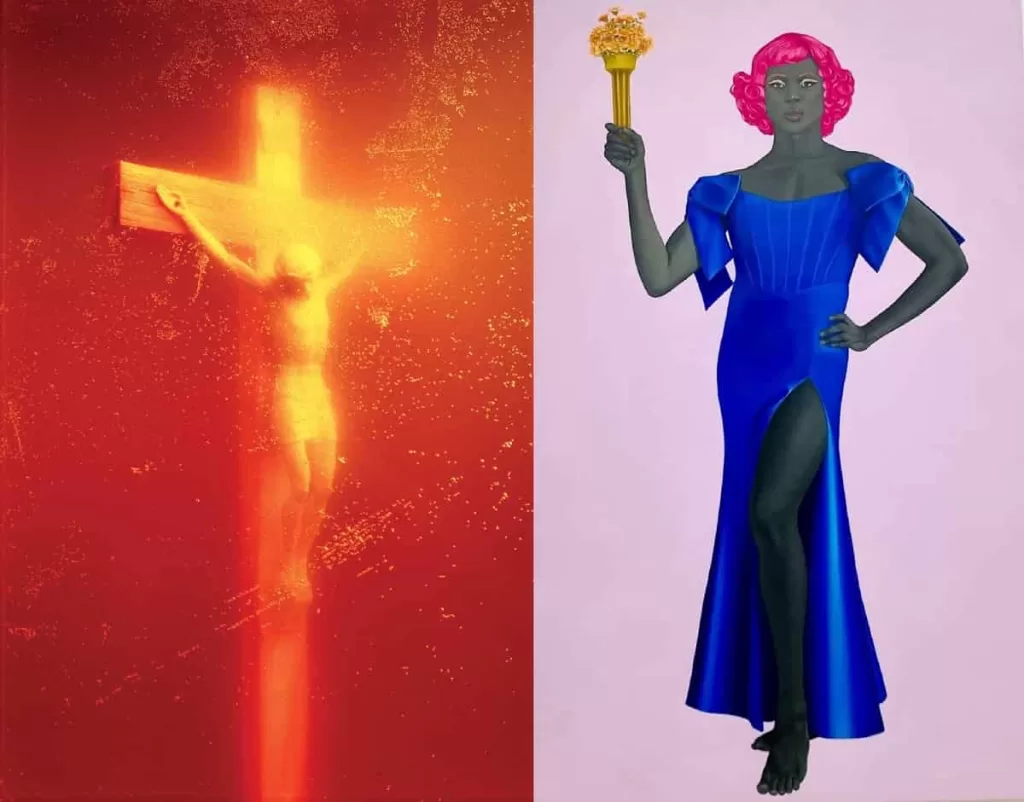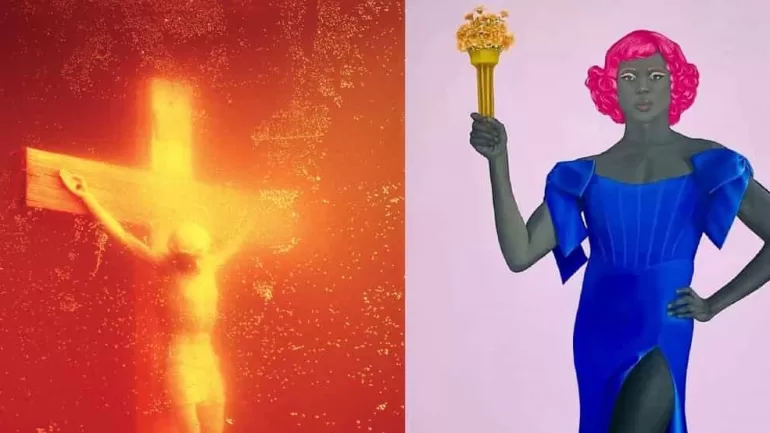ART & DESIGN
Two controversial Artworks: Andres Serrano’s Piss Christ 1987 and Amy Sherald’s Trans Forming Liberty
Unpack the controversies surrounding iconic controversial artworks. See how Piss Christ and Trans Forming Liberty reflect changing societal tensions.
BY KAZEEM ADELEKE, ARTCENTRON
Controversial artworks often ignite fierce public debate. These works challenge societal norms, provoke introspection, and sometimes trigger intense outrage. Two works, Andres Serrano’s 1987 photograph, Piss Christ, and Amy Sherald’s 2024 painting, Trans Forming Liberty, are important examples. Both pieces have generated significant controversy. These distinct cases, separated by decades, illuminate a shifting landscape of public offense and the evolving battlegrounds of culture wars in the United States. The specific nature of these controversies and their implications for artistic freedom and public institutions are central to this inquiry.
Andres Serrano’s Piss Christ: Blasphemy Culture Wars
Andres Serrano’s Piss Christ depicts a small plastic crucifix submerged in a glass tank of the artist’s urine. This photograph quickly became a flashpoint in America’s “culture wars” of the late 1980s and 1990s. The title and the unconventional medium, acknowledged by Serrano, immediately provoked accusations of blasphemy. The use of a bodily fluid to desecrate a sacred religious icon generated widespread visceral revulsion.
Many Christian groups and conservative politicians condemned Piss Christ. They argued it violated a sacred symbol. United States Senators Al D’Amato and Jesse Helms notably expressed outrage. They specifically criticized the fact that the work received funding from the taxpayer-funded National Endowment for the Arts (NEA). This public funding fueled the outrage. Consequently, Congress imposed significant cuts in the NEA’s budget, notably adding a “decency clause” to future grant requirements. This legislation signaled a chilling effect on federal arts patronage. The controversy demonstrated the direct legislative power wielded by political forces in response to controversial artworks.
Humiliation of the Crucifixion
Serrano, a lifelong Catholic, stated his intention was not blasphemy. Instead, he claimed the work commented on the commercialization and cheapening of Christian icons. He also suggested it alluded to the suffering of Christ on the cross, connecting bodily fluids to Christ’s death and suffering, echoing the humiliation of the crucifixion. Art critics, like Lucy R. Lippard, saw formal value in the piece, describing it as “darkly beautiful.”
The controversy surrounding Piss Christ took on various forms. Serrano received death threats and hate mail. The work was vandalized multiple times during exhibitions, notably in 1997 in Melbourne, Australia, and in 2011 in Avignon, France. Despite the condemnation, some Catholic figures, including Sister Wendy Beckett, an art historian, defended the work. They viewed it as a statement on society’s treatment of Christ rather than an insult. The enduring debate surrounding Piss Christ highlights the tension between religious sensitivities and artistic expression. This work remains a quintessential example of controversial artworks that challenge core beliefs and the very nature of sacredness.
Amy Sherald’s Trans Forming Liberty
Amy Sherald, renowned for her portrait of former First Lady Michelle Obama, created Trans Forming Liberty in 2024. This painting reimagines the iconic Statue of Liberty as a Black transgender woman. It features a figure with pink hair and a blue gown, holding a flower-filled torch. The work is part of her touring solo exhibition, “American Sublime.” The choice to depict a marginalized body as a universal symbol of freedom immediately positioned it as a powerful statement on contemporary American identity.
The recent cancellation of Sherald’s exhibition at the Smithsonian National Portrait Gallery brought Trans Forming Liberty into sharp focus. Sherald withdrew her show just last week after representatives of the museum allegedly suggested altering or removing the portrait. They expressed “internal concerns” about the work. This decision directly links to a broader climate of political hostility toward trans lives and executive orders issued by the administration, which target “divisive narratives” and Diversity, Equity, and Inclusion (DEI) initiatives within federal institutions like the Smithsonian. The resignation of National Portrait Gallery director Kim Sajet in June, following reported pressure, further underscores the political climate influencing museum decisions.
The controversy involves accusations of censorship and direct political pressure. Vice President JD Vance, reportedly overseeing the implementation of executive orders, raised concerns about the painting. He deemed it “woke and divisive content.” These executive orders mandate that Smithsonian exhibits must not “degrade shared American values” or promote “ideologies inconsistent with federal law and policy.”
Culture of Censorship
Sherald firmly rejected the proposed removal or alteration of her work. She stated, “This painting exists to hold space for someone whose humanity has been politicized and discarded.” She refused to “comply with a culture of censorship, especially when it targets vulnerable communities.” The Smithsonian initially claimed a proposed video was to “contextualize” the painting, not replace it. Sherald, however, asserted the video would open the value of trans visibility to debate, which she opposed as diluting her artistic statement and affirming a false equivalency.
The cancellation of Sherald’s show underscores the ongoing struggle for diverse representation in public institutions. It also highlights the increasing politicization of art and the formidable challenges artists face when their work addresses marginalized communities. Sherald’s decision to withdraw her exhibition demonstrates a resolute commitment to her artistic vision and the integrity of her subjects. Her painting joins the ranks of potent, controversial artworks.
A Shifting Landscape: Comparing of Controversial Artworks
These two instances, Piss Christ and Trans Forming Liberty, offer a stark comparison in the evolution of controversial artworks and the public’s reaction. The Piss Christ controversy primarily revolved around religious blasphemy and the use of federal funding for art deemed offensive. The resulting NEA funding cuts were a direct legislative consequence, a public punishment for perceived artistic transgression. The debate centered on traditional moral boundaries and the state’s role in subsidizing potentially sacrilegious content.
In contrast, the Trans Forming Liberty controversy highlights a significant shift in the primary battleground. While it involves a reinterpretation of a national symbol, the core offense pivots to identity politics and the affirmation of transgender humanity. The institutional response, as reported, involved internal pressure and the alleged suggestion of self-censorship from within the museum. This approach to decision-making differs from direct legislative defunding. Instead, it suggests a more insidious form of pressure and a chilling effect stemming from broader governmental directives against specific ideological content, often labeled “anti-woke.” This shift from outright legislative cuts to internal institutional preemption illustrates the evolving tactics and targets of cultural conflicts. Both cases, however, demonstrate the immense power of public and political opinion to influence artistic display and institutional autonomy. Both are truly controversial artworks.
Furthermore, a thematic link exists in the provocative use of the human body. In Piss Christ, it is the artist’s bodily fluid that transforms the sacred symbol into something unsettling and offensive for many. In Trans Forming Liberty, it is the specific body of a Black transgender woman embodying the nation’s highest ideal that becomes the site of contention, challenging traditional notions of national identity and who embodies “liberty.”
The Enduring Power and Peril of Controversial Artworks
Both Piss Christ and Trans Forming Liberty are profoundly controversial artworks. They illustrate the enduring power of art to provoke and challenge. Serrano’s work questioned religious piety and the commercialization of faith. Sherald’s piece champions visibility and human dignity for the transgender community. Both artists faced significant backlash for their creative choices. The controversies surrounding these controversial artworks force society to grapple with fundamental questions about artistic freedom, censorship, and the role of art in reflecting and shaping cultural values. These incidents underscore the continuous tension between artistic expression and public sentiment. They also highlight the precarious position of public cultural institutions navigating an increasingly polarized political landscape. Ultimately, art, especially that which pushes boundaries, remains a vital arena for societal dialogue and dissent. They are continuously testing the boundaries of tolerance and the integrity of our cultural institutions.

